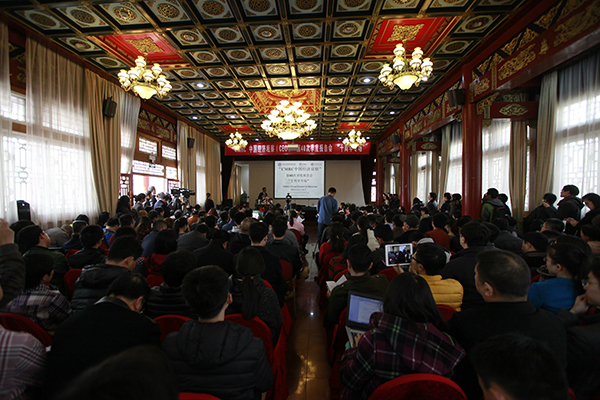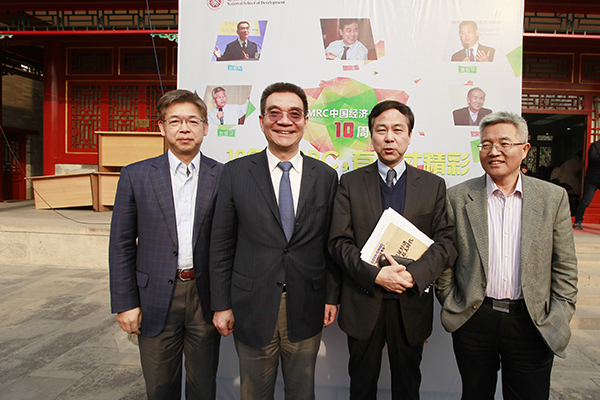

The “CMRC China Economic Observer” quarterly conference is an ongoing project at Peking University’s National School of Development (“NSD”) that began in 2005. Its aim is to utilize the NSD’s own research resources as well as invite top academics and experts in related fields to come together to analyze and discuss the latest topics in China’s economic development and short term macroeconomic trends in both China and the world. Senior professors such as Justin Lin, Yi Gang, Song Guoqing, Zhou Qiren, Huang Yiping and Lu Feng act as main speakers for the seminar which welcomes other Chinese experts to take part in discussions. In the past 10 years, the quarterly meeting has become a special class in observing and understanding the changing Chinese economy. It has frequently been reprinted and reported upon by numerous media outlets, giving it extensive influence.
“CMRC China Economic Observer(CEO)” Quarterly Review typically takes place on the third Saturday afternoon between 1.30pm and 5pm each February, April, July and October. The meeting consists of two sessions: the first session is a discussion of current hot topics concerning Chinese economic reform development whilst the second session discusses the current macroeconomic state and policies in China and abroad. In both sessions, there is a half-hour slot for speakers and Q&A. The first “CMRC China Economic Observer” was held in April, 2005. The second in July 2005 added a special appointed macroeconomic analysis body to provide the “Langrun Forecast” – it has grown from under ten to over thirty members.
The “Langrun Forecast” is one of China’s foremost macroeconomic indicator for quarterly forecasts. Specific forecasted indicators include GDP, CPI, Industry Added Value, Fixed Asset Investment, Consumer Product Sales, Imports, Exports, Interest rates, exchange rates etc. Aside from the NSD, the “Langrun Forecast” includes over 20 academic institutions, securities companies and financial organizations. The “Langrun Forecast” records and publishes each of the appointed organizations’ forecasted figures and builds on these figures to provide a comprehensive forecast result.
Compared with other similar seminars, the “CMRC China Economic Observer(CEO)” has some unique aspects. For example, whilst outside speakers are invited, key speakers are mainly NSD? professor, which maintains a Peking University ‘Langrun Gardens’ style. The format of the event – as explained above - is consistent and straightforward. As the event has maintained its focus over the last 10 years on key issues facing China’s economic reform and development, it has become a special class for both Peking University students and those interested in learning about Economic Studies.
The 40th “CMRC China Economic Observer” 10th anniversary special was held on 14th March, 2015, at Peking University National School of Development’s Wanzhong Building. It was presided over by NSD Professor Lu Feng. The seminar mainly discussed China’s economic reform & development, the global economic environment, short-term macroeconomic trends and other hot topics. NSD Honorary Dean Professor Justin Lin, Professor Huang Yiping, Zhang Weiying, Song Guoqing each gave a presentation and Q&A.
Professor Justin Lin first explained the state of economic development in 2014 for China and the global economy and noted the 7.4% growth rate of China’s GDP last year was one to be pleased with. However, Prof. Lin also noted the some areas such as China’s environment and food safety have issues that need to be addressed. He then analyzed the necessity and rationality of China’s 7% growth target for 2015. Finally, in order to boost China’s growth above 7%, Professor Lin emphasized some issues and refuted some misinterpretations in thinking.
Professor Huang Yiping began by examining the fall of the A-share market following the Central Bank’s lowering of the required reserve ratio and issues it raised such as “whether a steady monetary policy is neutral or is moderately easy”;” Whether price or quantitative monetary policy tools are more suitable” and “Whether the Central Bank should focus on inflation, growth or financial risk when deciding upon monetary policy”. In addition, he delved into policy targets, policy tools, policy frameworks and policy standpoints to explain China’s monetary policy issues.
Prof. Zhang Weiying began with economic theory, noting that neo-classical growth theory and Keynesian theory are both lacking. He believes that currently that discussion of Chinese economic growth and transition is usually taken from a Neo-classical or Keynesian viewpoint, which has a negative effect on China. Next, he analyzed the theory he believes is most suitable for China – the Schumpeterian growth model. Finally, using this model, Prof. Zhang explained the important role that entrepreneurs play in a country’s economic growth and made some related policy suggestions – to stop using incorrect theoretical models for economic growth and development and provide a freer and more suitable environment for entrepreneurs.
Prof. Song Guoqing described the changes in China’s economic growth speed and scale of credit in the two months preceding 2015 and what this meant for the economy. Next, he analyzed the falling asset-liability ratio for industrial enterprises. Finally, he gave his thoughts on reforms to company share registration and suggestions on the mechanisms for issuing new shares.
。
